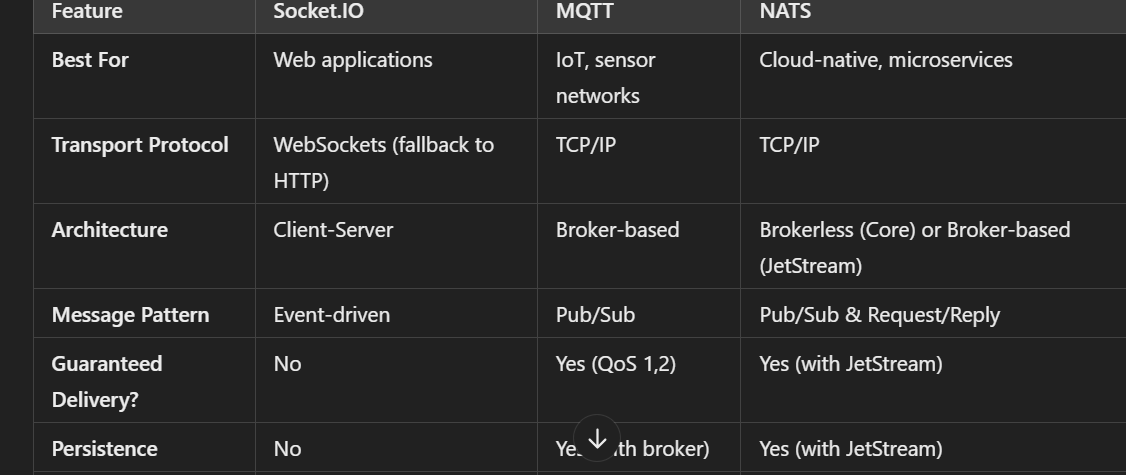Let's dissect difference between Socket.io,MQTT and NATS protocol
1️⃣ Socket.IO
🔹 What is it?
Socket.IO is a JavaScript library that provides real-time, bidirectional communication between web clients and servers. It is built on WebSockets but also supports HTTP long polling as a fallback.
🔹 How It Works
Uses a client-server model where clients (browsers, mobile apps) communicate with a server using WebSockets.
If WebSockets are unavailable, it falls back to long polling (HTTP-based technique).
Supports event-driven communication (messages are exchanged based on named events).
🔹 Key Features
✅ Event-based messaging (client and server can emit/listen to custom events).
✅ Automatic reconnection if the connection drops.
✅ Supports rooms & namespaces (for grouping clients).
✅ Works well for web-based real-time applications.
✅ Uses WebSockets, but falls back to HTTP polling if necessary.
🔹 When to Use Socket.IO?
✔️ Real-time web applications (chats, notifications, dashboards).
✔️ Collaborative tools (Google Docs-style live editing).
✔️ Gaming applications needing low-latency interaction.
🔹 Example Code (Node.js Server & Client)
📌 Server (Node.js)
const io = require("socket.io")(3000);
io.on("connection", (socket) => {
console.log("A user connected");
socket.on("message", (msg) => {
console.log("Message received:", msg);
socket.emit("response", "Message received");
});
});
📌 Client (JavaScript)
const socket = io("http://localhost:3000");
socket.emit("message", "Hello Server!");
socket.on("response", (data) => {
console.log("Server says:", data);
});
2️⃣ MQTT (Message Queuing Telemetry Transport)
🔹 What is it?
MQTT is a lightweight messaging protocol designed for low-bandwidth, high-latency, or unreliable networks. It follows a publish-subscribe (pub/sub) model and is widely used in IoT (Internet of Things) applications.
🔹 How It Works
Uses a broker-based architecture where publishers send messages to a broker, and subscribers receive them.
Works over TCP/IP with persistent connections.
Supports three levels of Quality of Service (QoS) to ensure message delivery.
🔹 Key Features
✅ Optimized for low-bandwidth networks (IoT, embedded systems).
✅ Supports persistent sessions (devices can reconnect and receive pending messages).
✅ Three QoS levels for message reliability:
QoS 0: At-most-once delivery (fire-and-forget).
QoS 1: At-least-once delivery (messages are acknowledged).
QoS 2: Exactly-once delivery (most reliable but slower).
✅ Retained messages & last will messages (useful for IoT devices).
🔹 When to Use MQTT?
✔️ IoT applications (smart home devices, sensors, telemetry).
✔️ Low-power, low-bandwidth environments.
✔️ Device-to-cloud communication (e.g., sending data from sensors to a cloud service).
🔹 Example Code (MQTT Broker & Client in Python)
📌 Broker Setup (Using Eclipse Mosquitto)
mosquitto -v # Start MQTT broker
📌 MQTT Publisher (Python)
import paho.mqtt.client as mqtt
client = mqtt.Client()
client.connect("localhost", 1883, 60)
client.publish("test/topic", "Hello MQTT!")
client.disconnect()
3️⃣ NATS (Network Attached Transient Storage)
🔹 What is it?
NATS is a high-performance messaging system designed for cloud-native applications, microservices, and real-time communication. It supports pub/sub, request/reply, and message queueing.
🔹 How It Works
Can work in brokerless (Core NATS) mode or broker-based (JetStream) mode.
Uses TCP/IP for fast and efficient message delivery.
Unlike MQTT, it does not maintain persistent sessions by default (unless using JetStream).
🔹 Key Features
✅ Lightweight and high-performance (written in Go).
✅ Supports pub/sub and request/reply patterns.
✅ Auto-healing & self-optimizing (no need for ZooKeeper or external coordination).
✅ Streaming support with JetStream (for message persistence).
✅ Secure communication with TLS & authentication.
🔹 When to Use NATS?
✔️ Microservices communication (alternative to Kafka or RabbitMQ).
✔️ Cloud-native applications requiring fast messaging.
✔️ Event-driven architectures (e.g., real-time analytics, live data processing).
🔹 Example Code (NATS Client in Go)
📌 NATS Server (Run in CLI)
nats-server -DV # Start NATS server
Go Publisher
package main
import (
"log"
"github.com/nats-io/nats.go"
)
func main() {
nc, _ := nats.Connect(nats.DefaultURL)
nc.Publish("updates", []byte("Hello NATS!"))
nc.Close()
}
Go Subscriber
package main
import (
"fmt"
"github.com/nats-io/nats.go"
)
func main() {
nc, _ := nats.Connect(nats.DefaultURL)
nc.Subscribe("updates", func(m *nats.Msg) {
fmt.Printf("Received: %s\n", string(m.Data))
})
select {} // Keep running
}
5️⃣ Final Thoughts: Which One to Choose?
🔹 Use Socket.IO if you're building real-time web apps (chats, dashboards, gaming).
🔹 Use MQTT if you need low-bandwidth, reliable messaging for IoT devices.
🔹 Use NATS for high-performance, cloud-native, and microservices communication.


